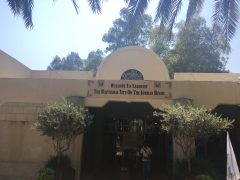 I describe myself as a religious person. My faith is important to me. I grew up in the Anglican Church and I am now a member of the United Church. I grew up hearing the stories of the people in the desert, the stories of Jesus. For those reasons alone, getting to see and experience the places I’ve always heard about, I was very excited to travel to Israel for this course. Not only was I going to learn a ton about the people, the country and other religions such as Judaism and Islam, I was going to have the in person experiences at all these historical Christian sites. In a way, it was a sort of pilgrimage for me. A pilgrimage, according to Barber, is “A journey resulting from religious causes, externally to a holy site, and internally for spiritual purpose and internal understanding” (1993, 1). Pilgrimage is required in some religions, but is not a requirement within the Christian faith, yet one that is oftentimes undertaken on a voluntary basis.
I describe myself as a religious person. My faith is important to me. I grew up in the Anglican Church and I am now a member of the United Church. I grew up hearing the stories of the people in the desert, the stories of Jesus. For those reasons alone, getting to see and experience the places I’ve always heard about, I was very excited to travel to Israel for this course. Not only was I going to learn a ton about the people, the country and other religions such as Judaism and Islam, I was going to have the in person experiences at all these historical Christian sites. In a way, it was a sort of pilgrimage for me. A pilgrimage, according to Barber, is “A journey resulting from religious causes, externally to a holy site, and internally for spiritual purpose and internal understanding” (1993, 1). Pilgrimage is required in some religions, but is not a requirement within the Christian faith, yet one that is oftentimes undertaken on a voluntary basis.
Not everyone who comes to Israel does so for a religious experience, and that included some people on this trip. I do not want to assume what they felt or experienced while visiting the sites, but I suspect that there was no expectation that they would “feel” anything, outside of a learning experience. This is something that I struggled with during the trip. I did have the expectation that I would feel a spiritual connection visiting the Mount of Olives. the Mount of Beatitudes or walking the Via Dolorosa, but if anything I just felt frustrated and kind of disappointed. While walking the Dolorosa we would stop at places such as where Jesus fell, or leaned against the wall and a juice stand would be across the street yelling about selling orange juice. It did not feel very spiritual to me. Every site had a gift store filled with cheap-feeling souvenirs, with the same things being sold at most places. I felt conflicted about thinking of the idea of buying a shot glass at a religious place. It felt like it was disrespectful to the site, to the history that took place. Ironically, I also struggled with the fact that most of the places where filled with people visiting on their own pilgrimages and tours. So many places were just so busy that it was hard to connect with the space. It was a harsh contradiction because I was mad that people were coming to see the sites when I was doing the same thing.
Many of the sites we visited on this trip were filled with pilgrims from all over the world. People came to be baptized at the Yardenit Baptism site from places such as India, South Africa and the United States. This is a place where people decided to go to feel closer to their faith. It was a choice that they made for themselves. Some pilgrimages are required by the religion such as the pilgrimage to the Hajj in Mecca for Muslims, while some are purely spiritual like visiting important places in the bible for Christians and Jews.
We were able to visit the Baha’i Gardens on our last day of the course itself. This place faces many of the same contradictions that I have felt during the trip. From doing further reading on the gardens and the experiences that people have, I was able to learn more about two distinct ways that people experience these sites. There is very much the experience of a religious pilgrim at the gardens, getting to experience the shrine of the forerunner of the founder of your faith is amazing. The gardens however are also a place that secular tourists, meaning non-religious, visit as well for the amazing beauty of the Gardens. This is the situation all over Israel. Trying to find a way to share spaces that are sacred to many, but not all. There is a practically that comes into play, of needing to maintain the sites, to manage the visitors, yet leave space for the mysterious, for faith. This is Israel in a nutshell, a place of contrast and challenge between secularism and religion.
By: Jessica Stevenson
Sources:
Barber R. Pilgrimages. 1993. The Boydell Press.
Collins-Kreiner. N., Gatrell, J. 2006. Tourism, Heritage and Pilgrimage: The Case of Haifa’s Baha’i Gardens. Journal of Heritage Tourism, 1:1, 32-50.
